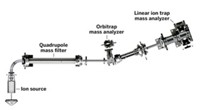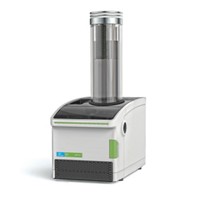Advertisement
Grab your lab coat. Let's get started
Welcome!
Welcome!
Create an account below to get 6 C&EN articles per month, receive newsletters and more - all free.
It seems this is your first time logging in online. Please enter the following information to continue.
As an ACS member you automatically get access to this site. All we need is few more details to create your reading experience.
Not you? Sign in with a different account.
Not you? Sign in with a different account.
ERROR 1
ERROR 1
ERROR 2
ERROR 2
ERROR 2
ERROR 2
ERROR 2
Password and Confirm password must match.
If you have an ACS member number, please enter it here so we can link this account to your membership. (optional)
ERROR 2
ACS values your privacy. By submitting your information, you are gaining access to C&EN and subscribing to our weekly newsletter. We use the information you provide to make your reading experience better, and we will never sell your data to third party members.
Analytical Chemistry
ASMS Instrument Roundup
June 30, 2014
| A version of this story appeared in
Volume 92, Issue 26
Earlier this month, 6,600 mass spectrometrists gathered in Baltimore for the 62nd meeting of the American Society for Mass Spectrometry. At the meeting, companies launched new and updated instruments. This roundup of new products—not intended to be comprehensive—summarizes information from vendors.

There’s a new record for high-field magnets in mass spectrometry. Bruker has installed a 21-tesla superconducting magnet at the National High Magnetic Field Laboratory (NHMFL) at Florida State University. The magnet, which will be the heart of a new Fourier transform ion cyclotron resonance (FT-ICR) mass spectrometer, was designed and built in collaboration with scientists at NHMFL. It has the highest field ever used for MS; the largest magnet previously available has a magnetic field of 15 tesla. Alan G. Marshall, director of the FT-ICR program at NHMFL, expects the magnet to boost the throughput of the instrument without any loss of mass resolution for applications involving large species such as intact proteins and protein complexes. The instrument is currently being assembled and is expected to be up and running by early fall. Such magnets could also prove valuable for magnetic resonance imaging, said Frank H. Laukien, Bruker president and chief executive officer. Before shipping the magnet to NHMFL, Bruker scientists used the magnet to acquire MRI images of a mouse brain.
AB Sciex launched the TripleTOF 6600 with a new version of the company’s SWATH acquisition system. The instrument has increased dynamic range relative to its predecessors. It is aimed at solving the so-called “missing data problem” in proteomics. The improved SWATH 2.0 is a data-independent strategy for acquiring tandem mass spectra. It results in the fragmentation of every detectable peptide in a proteomic sample to acquire comprehensive MS/MS data. In some experiments, it has nearly doubled the number of peptides that can be reproducibly detected, company representatives said.
Bruker launched the Impact II, an ultra-high-resolution quadrupole time-of-flight mass spectrometer. The instrument is aimed at the proteomics market, especially people interested in doing analysis of intact proteins or top-down proteomics. The instrument achieves resolving power of 50,000, which allows proteins up to 30 kilodaltons to be analyzed with isotopic resolution. When combined with ultra-high-performance liquid chromatography (UHPLC), it can resolve more than 1,000 proteoforms in less than 30 minutes. Bruker also featured an updated Autoflex Speed, a tandem time-of-flight (TOF/TOF) instrument with a 2-kHz laser for faster matrix-assisted laser desorption ionization (MALDI) analysis.
Shimadzu launched the GCMS-TQ8040, a triple-quadrupole gas chromatograph/mass spectrometer. The most striking feature of the new instrument is its built-in method optimization tool, called Smart MRM (multiple reaction monitoring). The system has a compound database from which it can pull information to develop methods, or it can start from scratch to develop methods for unknowns. The Smart MRM optimization collects product ion scan data and determines the optimal collision energy for each transition between parent and product ions. Once determined, those values can be saved in the database as well.
Two companies introduced entry-level instruments. AB Sciex launched the Triple Quad 3500. This system is aimed at the food and environmental markets. It offers faster scan speeds, improved switching between positive and negative modes, better sensitivity, and updated electronics relative to its predecessor. AgilentTechnologies announced the 6120VL single-quadrupole detector for liquid chromatography. The new detector, which is based on the 6120 SQ instrument, is fully integrated with Agilent’s UHPLC systems and can be upgraded.

Thermo Fisher Scientific launched two new instruments. To create the Q Exactive HF, the company added a high-field Orbitrap mass analyzer to its Q Exactive Plus instrument. The new instrument has a maximum scan rate of 18 Hz and resolving power of 240,000 at a mass-to-charge ratio of 200. The system has an optional intact protein mode to improve the analysis of intact proteins. Thermo Fisher also introduced the TSQ 8000 triple-quadrupole GC/MS system. The instrument features a new collision cell that enables faster analysis without a loss in sensitivity. More than 1,000 compounds can be analyzed in a single run.
Agilent Technologies launched two new triple quadrupole mass spectrometers, one for gas chromatography and one for LC. The 7010 Triple Quadrupole GC/MS has a redesigned electron impact ionization source that enables detection limits at attogram levels, which the company claims is the best achieved by any electron impact GC/MS/MS system. The improved sensitivity will allow users to inject smaller sample volumes and increase the number of samples that can be analyzed in intervals between maintenance dates. The 6495 LC/MS Triple Quadrupole system is the latest addition to the company’s 6400 LC/MS triple quadrupole series. It achieves a five-fold improvement in sensitivity and an instrument detection limit of 0.75 femtogram.
Waters Corp. added two new members to its Xevo family of instruments. The Xevo G2-XS is a benchtop quadrupole time-of-flight instrument. The G2-XS features a new collision cell. The instrument’s TOF-MRM mode has 10-fold better signal-to-noise ratio than full-scan mode. The Xevo TQ-S micro is a compact tandem quadrupole mass spectrometer. Its Xtended Dynamic Range technology gives the instrument six orders of magnitude of linear dynamic range. It can acquire as many as 500 reaction transitions per second without reducing peak intensity. In addition, Waters announced that it has signed an agreement with Prosolia for the exclusive use of Prosolia’s DESI (desorption electrospray ionization) source for clinical applications.









Join the conversation
Contact the reporter
Submit a Letter to the Editor for publication
Engage with us on Twitter